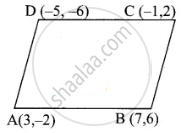Advertisements
Advertisements
प्रश्न
Verify that the following points taken in order to form the vertices of a rhombus
A(3, −2), B(7, 6), C(−1, 2) and D(−5, −6)
उत्तर

Distance = `sqrt((x_2 - x_1)^2 + (y_2 - y_1)^2`
AB = `sqrt((7 - 3)^2 + (6 + 2)^2`
= `sqrt((4)^2 + (8)^2`
= `sqrt(16 + 64)`
= `sqrt(80)`
BC = `sqrt((-1 - 7)^2 + (2 - 6)^2`
= `sqrt((- 8)^2 + (- 4)^2`
= `sqrt(64 + 16)`
= `sqrt(80)`
CD = `sqrt((-5 + 1)^2 + (-6 - 2)^2`
= `sqrt((- 4)^2 + ( - 8)^2`
= `sqrt(16 + 64)`
= `sqrt(80)`
AD = `sqrt((-5 - 3)^2 + (- 6 + 2)^2`
= `sqrt((- 8)^2 + (- 4)^2`
= `sqrt(64 + 16)`
= `sqrt(80)`
AB = BC = CD = AD = `sqrt(80)`
All the four sides are equal.
∴ ABCD is a rhombus.
APPEARS IN
संबंधित प्रश्न
Sketch proper figure and write the answer of the following question.
If A- B - C and l(AC) = 11, l(BC) = 6.5, then l(AB) = ?
Sketch proper figure and write the answer of the following question.
If X-Y-Z and l(XZ) = `3sqrt7`, l(XY) = `sqrt7`, then l(YZ) = ?
Co-ordinates of the pair of points are given below. Hence find the distance between the pair.
-9, -1
Co-ordinates of the pair of points are given below. Hence find the distance between the pair.
- 25, - 47
If A-B-C and d(A, C) = 17, d(B, C) = 6.5 then d(A, B) = ?
Show that the following points taken in order to form an isosceles triangle
A(5, 4), B(2, 0), C(−2, 3)
Show that the following points taken in order to form the vertices of a parallelogram
A(−7, −3), B(5, 10), C(15, 8) and D(3, −5)
A(−1, 1), B(1, 3) and C(3, a) are point and if AB = BC, then find ‘a’
The distance between the point (5, −1) and the origin is _________
Find the distance with the help of the number line given below.

d(K, O)
